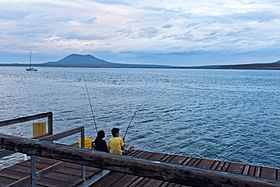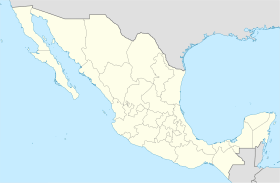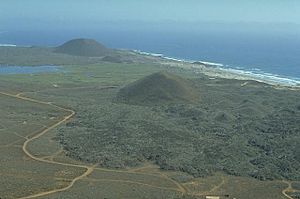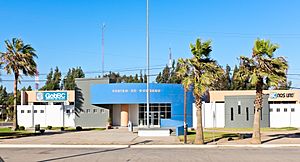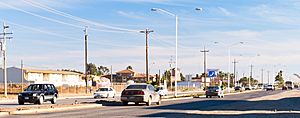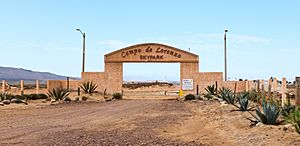San Quintín, Baja California facts for kids
Quick facts for kids
San Quintín, Baja California
|
|
|---|---|
|
View of the Bay of San Quintín
|
|
| Country | |
| State | |
| Municipality | San Quintín |
| Area | |
| • Land | 14,263 sq mi (36,941 km2) |
| Elevation | 92 ft (28 m) |
| Population
(2010)
|
|
| • City | 4,777 |
| • Urban | 4,777 |
| Time zone | UTC-8 (Northwest US Pacific) |
| • Summer (DST) | UTC-7 (Northwest) |
San Quintín is a city in San Quintín Municipality, Baja California, Mexico. It's located right on the Pacific Ocean coast. In 2011, about 4,777 people lived there. San Quintín is a big farming area for Baja California. It's also becoming a popular place for tourists, famous for its sandy dunes and beautiful beaches.
Contents
History of San Quintín
In the early 1800s, people hunted sea otters in San Quintín Bay. American fur traders and the Russian-American Company worked together. They used small boats called baidarkas and Alaskan hunters. They hunted sea otters all along the coast. Because of this, sea otters in Baja California almost disappeared.
British Settlement and Farming
In the 1880s, a British company bought land in San Quintín. They wanted to grow a lot of wheat. About 100 English families moved there. They bought land, planted wheat, and built a mill to make flour.
To move the flour, the English built a pier in the bay. They also started building a railway. This railway was meant to connect to tracks in California. They laid 30 kilometers of track. But then, the colony failed. A 17-ton train engine still lies underwater near the bay. It fell during a loading accident.
A bad drought ruined the first wheat crops. By 1900, all the English families left San Quintín.
Remains of the Past
You can still see parts of the old mill, the railway, the pier, and an English cemetery. The names on the old wooden crosses in the cemetery have faded. Newer Mexican graves are now next to them.
Modern Developments
Recently, people from other countries, especially China, have invested in San Quintín. They are helping to grow and export shellfish, like abalone. A new hotel for tourists is also planned.
San Quintín has a project to protect abalone. They grow abalone on farms for two to three years. Then, they put them back into the ocean. After three more years, the abalone are harvested to be sold. This helps keep the abalone population healthy.
Becoming a Municipality
On October 28, 2015, people in San Quintín voted. Most people wanted San Quintín to become its own municipality. On February 27, 2020, San Quintín officially separated from the municipality of Ensenada. It became the sixth municipality in the state. In 2010, about 80,000 people lived in the farming area around San Quintín.
Geography and Climate
San Quintín's Weather
The weather in San Quintín is usually warmer in summer and cooler in winter than in San Diego. But right along the Pacific Ocean coast, about 5 miles west of San Quintín, the weather is very similar to San Diego's all year round.
Economy
San Quintín is home to the biggest farming company in Baja California, called Los Pinos.
Aquaculture: Farming the Sea
Aquaculture means farming plants and animals in water. San Quintín has a huge chance for growth in this area. The long coastline along the Pacific and the Sea of Cortes is perfect for it. New technology and the desire to grow marine fish and shellfish have made aquaculture a big part of Baja California's economy.
Growing oysters, mussels, and abalone has made aquaculture important in the fishing industry. The demand for seafood is growing worldwide. Baja California is a leader in aquaculture. Since natural fishing resources are being used a lot, aquaculture helps meet the demand for food.
Fishing is a long-standing tradition in Baja California. Its seafood is known worldwide for its quality. Businesses here trade with places like Europe, Asia, the United States, and other parts of Mexico. There are many facilities to support the fishing industry. These include factories, freezers, and places that make packaging.
There are also shipyards and workshops for fishing boats. Important research centers for aquaculture train students from high school to doctoral levels. This industry has grown a lot in just the last two decades.
One of the biggest successes is oyster farming in San Quintín. Ostiones Guerrero, SA de CV, is the oldest and largest producer of Pacific Gigas and Kumamoto oysters. They have a restaurant called La Ostionera where people enjoy fresh oysters. Local oyster farms produce over 1,000 tons each year, along with mussels and abalone. The bay is approved by the United States Food and Drug Administration. This means the products are high quality and can be sold in the US.
San Quintín is close to California, which is a big market for seafood. Seafood from Baja California crosses the border into San Diego, California. From there, live fish and fresh seafood are sent to places like the Tsukiji fish market in Tokyo, Japan.
Media
XEQIN-AM is a government-run community radio station in San Quintín. It broadcasts in Mixtec, Zapotec, and Triqui languages. These are languages spoken by native people in Mexico.
Transportation
You can reach San Quintín by land using Federal Highway 1. This highway goes from Cabo San Lucas to Tijuana. For air travel, the San Quintín Valley has several small airstrips:
- Cielito Lindo
- El Buen Pastor Airstrip
- El Pedregal
- Los Pinos
- Rancho Magaña
The San Quintín Airport is the only paved airstrip. However, it is a military field, so it's only used for military planes. The closest airports where you can enter the country are Ensenada and Tijuana.
See also
 In Spanish: San Quintín (Baja California) para niños
In Spanish: San Quintín (Baja California) para niños


